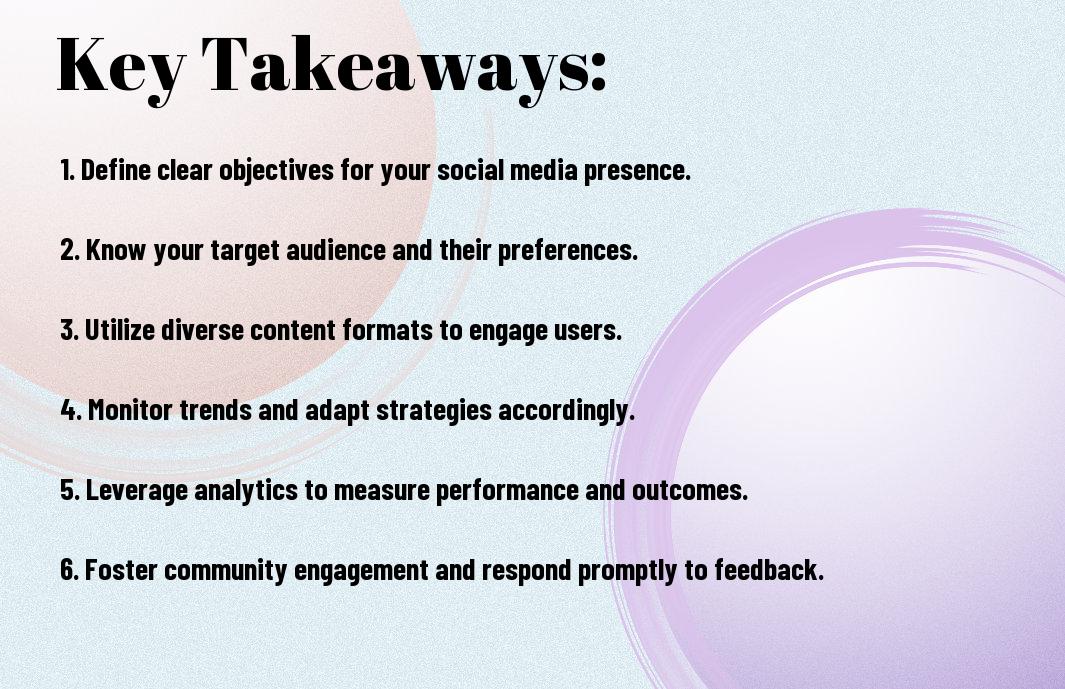You’re likely aware of the significance of social media in promoting your products and services. As you navigate the digital landscape, you need a well-planned strategy to stand out from the competition. Your social media presence can make or break your brand’s reputation, and a winning strategy will help you reach your target audience, increase engagement, and drive sales. You will learn how to develop a tailored approach that showcases your brand and resonates with your customers.
Key Takeaways:
- Define your target audience and understand their needs to create content that resonates with them and effectively promotes your products and services on social media platforms.
- Develop a content calendar that outlines the type of content to be posted, the frequency of posts, and the social media channels to be used, ensuring consistency and efficiency in your social media strategy.
- Monitor and measure the performance of your social media strategy using analytics tools, allowing you to track engagement, identify areas for improvement, and make data-driven decisions to optimize your strategy and increase the visibility of your products and services.


Defining Your Social Media Goals
A well-defined social media strategy starts with clear goals. You need to determine what you want to achieve through your social media presence, whether it’s increasing brand awareness, driving website traffic, or generating sales. Your goals will serve as a guide for your social media efforts, helping you focus on what’s important and measure your success.
Setting Measurable Objectives
Methodically, you will need to set specific, achievable objectives that align with your overall social media goals. You should establish targets that are quantifiable, allowing you to track your progress and adjust your strategy as needed. This will help you stay on track and ensure your social media efforts are yielding the desired results.
Aligning Goals with Business Values
The key to a successful social media strategy is ensuring your goals align with your business values and mission. You should consider what matters most to your organization and how your social media presence can support those values. This will help you create a cohesive and authentic online presence that resonates with your target audience.
Aligning your social media goals with your business values is necessary to creating a strategy that truly reflects your brand. You will want to consider how your social media presence can help you achieve your business objectives, while also staying true to your organization’s mission and values. By doing so, you will be able to create a social media strategy that is not only effective but also authentic and meaningful to your target audience.
Knowing Your Target Audience
It is vital to understand who your target audience is, as this will help you create a social media strategy that resonates with them. You need to identify their interests, preferences, and behaviors to create content that appeals to them.
Creating Audience Personas
The key to creating effective audience personas is to gather as much information as possible about your target audience. You can do this by conducting surveys, analyzing customer data, and researching industry trends to create a detailed profile of your ideal customer.
Platform Selection Based on Demographics
Between different social media platforms, you will find varying demographics, and selecting the right one for your business depends on your target audience’s age, location, and interests. You should choose the platforms where your audience is most active.
Based on your target audience’s demographics, you can select the most suitable social media platforms for your business. For example, if your target audience is younger, you may want to focus on TikTok or Snapchat, while an older audience may be more active on Facebook or LinkedIn. You can analyze your audience’s demographics and adjust your social media strategy accordingly to maximize your reach and engagement.
Content Strategy Development
For a successful social media strategy, you need to develop a content strategy that aligns with your business goals. This involves creating content that resonates with your target audience and sets your brand apart from the competition.
Content Pillars and Themes
Strategically, you will need to identify the core topics and themes that will guide your content creation. This will help you create a consistent tone and message across all your social media platforms, making it easier for your audience to understand your brand’s value proposition.
Content Calendar Creation
Around the time you start planning your content, you should consider creating a content calendar to organize and schedule your posts in advance. This will help you ensure consistency and efficiency in your content publishing process.
Calendar management is key to maintaining a consistent flow of content on your social media channels. You can use a physical calendar or a digital tool to plan and schedule your posts, taking into account peak engagement times, special events, and product launches to maximize your content’s impact and reach a wider audience.
Platform-Specific Tactics
Once again, you’ll need to consider the unique characteristics of each social media platform when developing your strategy. This involves understanding the strengths and weaknesses of each platform and tailoring your approach accordingly.
Choosing Primary Platforms
Between the various social media options, you’ll need to select the ones that best align with your target audience and business goals. You’ll want to focus on the platforms where your audience is most active and engaged.
Adapting Content for Each Channel
Beside the platform’s unique features, you’ll also need to consider the type of content that performs well on each channel. You’ll want to create content that resonates with your audience and is optimized for each platform’s specific format.
Due to the diversity of social media platforms, adapting your content for each channel is vital. You’ll need to consider factors such as image size, video length, and tone of voice to ensure your content is effective and engaging on each platform. By doing so, you’ll be able to maximize your reach and impact, and ultimately drive more sales and conversions for your products and services.
Engagement and Community Building
All successful social media strategies involve building a community around your products and services, and this is achieved through engagement with your audience. You need to interact with your followers, respond to their comments, and create content that sparks conversations. By doing so, you will be able to build trust and loyalty with your customers, which is imperative for the growth of your business.
Response Strategy
Above all, your response to customer inquiries and comments should be timely and personalized. You should have a plan in place for responding to both positive and negative feedback, and ensure that your tone is consistent across all social media platforms. This will help you to build a strong reputation and show your customers that you value their feedback.
Community Management Guidelines
Any community management strategy should include guidelines for posting content, responding to comments, and engaging with your audience. You should establish a set of rules for your social media accounts, including what type of content is acceptable and how you will handle spam or abusive comments. This will help you to maintain a positive and respectful community.
Indeed, developing community management guidelines is an ongoing process that requires continuous monitoring and evaluation. You should regularly assess your social media analytics to see what is working and what areas need improvement, and make adjustments to your strategy accordingly. By doing so, you will be able to create a thriving community that supports your business goals and helps you to achieve success in the competitive market. You will be able to build strong relationships with your customers, increase brand awareness, and drive sales, which is imperative for the growth and success of your business.
Analytics and Performance Tracking
After setting up your social media strategy, you need to monitor its performance to see what works and what doesn’t. You can learn more about creating a social media strategy by checking out 9 Steps to Create a Social Media Strategy (with Template) to improve your approach.
Key Metrics to Monitor
By tracking your social media metrics, you can identify areas for improvement and optimize your strategy to achieve better results, helping you understand your audience and their engagement with your content.
Reporting and Adjustments
Around the same time, you’ll need to analyze your performance data to make informed decisions about your social media strategy, which will help you refine your approach and achieve your goals.
At this stage, you’ll be able to see what’s working and what’s not, and make adjustments to your strategy accordingly, allowing you to refine your approach and achieve your goals, and as you continue to monitor and adjust your strategy, you’ll be able to optimize your social media presence and maximize your return on investment.
Final Words
The key to a successful social media strategy is understanding your audience and creating content that resonates with them. You can develop a winning strategy by setting clear goals, analyzing your competition, and tracking your performance. For more information, you can visit Social media marketing: Strategy template and tips for 2025 to learn how to optimize your approach and boost your brand’s online presence, helping you achieve your business objectives and grow your customer base effectively.
FAQ
Q: What is the first step in creating a winning social media strategy for my products and services?
A: The first step in creating a winning social media strategy is to define your target audience and understand their needs, preferences, and behaviors. This involves conducting market research, analyzing your competitors, and identifying your unique selling proposition (USP). By understanding your audience, you can create content that resonates with them and addresses their pain points, ultimately driving engagement and conversions. Additionally, you should also determine your social media goals, such as increasing brand awareness, generating leads, or driving sales, to help guide your strategy.
Q: How do I choose the right social media platforms for my products and services?
A: Choosing the right social media platforms for your products and services depends on your target audience and their preferred platforms. For example, if your target audience is primarily visual, Instagram and Pinterest may be good choices. If your target audience is more professional, LinkedIn may be a better fit. You should also consider the type of content you want to create and share, as well as the resources you have available to manage and maintain your social media presence. It’s also important to note that you don’t need to be on every social media platform, focus on the ones that align with your goals and audience.
Q: What type of content should I create to engage my target audience on social media?
A: The type of content you create should be informative, entertaining, and relevant to your target audience. This can include blog posts, videos, infographics, podcasts, and social media posts that showcase your products and services. You should also consider creating content that tells a story, showcases customer testimonials, and highlights the benefits of your products and services. Additionally, you can use user-generated content, behind-the-scenes content, and live streaming to add variety and authenticity to your content mix. The key is to create content that resonates with your audience and encourages engagement and sharing.
Q: How often should I post on social media to maximize engagement and reach?
A: The frequency of your social media posts depends on your audience, the platform, and your goals. As a general rule, you should post content that is consistent in terms of quality and frequency, but not so frequent that it becomes spammy or overwhelming. For example, you may post on Facebook and Twitter several times a week, while Instagram and LinkedIn may require less frequent posting. You should also consider using a content calendar to plan and schedule your posts in advance, as well as monitor your analytics to see what works best for your audience. Additionally, you can use social media management tools to help you schedule and automate your posts.
Q: How do I measure the success of my social media strategy and make adjustments as needed?
A: Measuring the success of your social media strategy involves tracking your key performance indicators (KPIs) such as engagement rates, website traffic, lead generation, and conversions. You can use social media analytics tools to monitor your performance and adjust your strategy accordingly. For example, if you find that your engagement rates are low, you may need to adjust your content mix or posting frequency. If you find that your website traffic is high, but conversions are low, you may need to adjust your landing page or call-to-action. By regularly monitoring your analytics and making adjustments as needed, you can optimize your social media strategy and achieve your goals.



